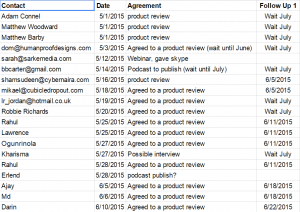
This past weekend my son and I went camping with the local Boy Scout troop.
There’s a camping trip every single month and the Scouts are totally in charge of planning and preparation. The scouts develop meal plans, assign roles and responsibilities for each patrol, and pretty much prepare for almost every possible situation.
And every single camping trip is a resounding success!
This got me thinking that the Boy Scout motto also applies to year-end fundraising: Be Prepared!
December 31st is three months from now, but NOW is the right time to prepare. The more prepared you are, the more likely you will hit (and exceed) your goals.
So how should you prepare? In this post, I’ll outline the three key areas you should focus on now:
1. Understand your people (your audience segments)
2. Develop your story (your messaging and your ask)
3. Write it down (your fundraising plan)
Let’s get started!
Step 1: Understand your people
The biggest mistake many nonprofits make is treating everyone in their database the same. Successful nonprofits understand that each person has a different relationship with their organization, so create a strategy for each audience segment.
Examples of audience segments to consider:
- People who gave last year
- First-time donors
- Repeat donors
- Small, mid, major donors
- Newsletter subscribers and other email lists
Next, you want to develop an understanding of what motivates your supporters. Their reasons, not yours. And those reasons need to be emotional, not big statistics or assumptions you’ve made about why they give. You can begin researching each audience segment by asking the following questions:
- Which campaigns drove the most donations?
- Which programs matter most to donors?
- Which stories drove the highest conversions for each segment?
Lastly, you can also use tools like Facebook Insights, Facebook Audience Insights, and Facebook Graph to get a better sense for deeper demographics, as well as the topics and interests that engage your overall community.
Step 2: Develop your story
Once you understand your people better, you’ll need to start developing your story.
Without a solid story, you’ll lack the emotional oomph that’s needed to engage supporters during your annual appeal. Statistics won’t cut it, bragging about your nonprofit won’t cut it, and certainly begging won’t cut it.
But what if you’re not a natural storyteller? Well, everyone is — in fact, we’re all deeply hard-wired for stories, so be confident.
Just make sure your story follows the Hook Hold Payoff formula:
1. The Hook
If a story doesn’t hook people in the first few milliseconds, it won’t move people to take action. You have to trigger an emotion. You and I both know this, and so do the brain scientists. In short, focus on the feels.
2. The Hold
Great stories hold our attention after we’re hooked. We continue to pay attention as long as there are unanswered questions.
The Hold keeps people engaged until plot questions are answered, or until the story is resolved. Will the grandmother win her fight against breast cancer so she can live to see her grandkids?
3. The Payoff
The Payoff is the resolution to the plot questions, and thus, the story. The Payoff is so essential, that without a it, you really don’t have a story at all. The payoff is also where you invite the potential supporter to play a part in how the story ends: Give clean water, feed a hungry child, stop the hate, etc. The payoff essentially is a call-to-action.
Step 3: Write it down
It’s not a plan if it’s not written down. Surprisingly (or not), many nonprofits have a written plan for year-end. Create a written plan NOW for year-end. This will instantly place you ahead of the pack!
So what does a plan actually look like?
The POST method, originally coined by Charlene Li and Josh Bernoff in their book, Groundswell (Harvard Business Review Press) is a proven framework for developing any online strategy.
P – People
You can’t achieve even a basic level of success on social media if you don’t understand your people. No one will like, retweet, or repin your blog post if you haven’t answered the only question that really matters: What’s in it for them?1
O – Objectives
If you don’t have a destination any tool will do. Any best practice will do too.
Clear objectives helps you determine if you were successful or not. Long-term success on social media requires a lot of trial and error. But you have to know what’s a trial and what’s in error. Plus, they help you discover what you’re doing right!
S – Strategy
Your strategy is more than just a plan. It’s a plan that will meet your objectives based on what you know about your people.
In other words, strategy is about a value exchange.
What are you going to give in exchange for their email, money, time, influence and attention?
Whether it’s a meaningful pledge, or a sweepstakes, write down exactly how you will offer enough value to encourage them to help you achieve your objective.
T – Technology
Once you understand your people, objective, and strategy, you can confidently select the tools and tactics you’ll use for your campaign. For example, if your strategy is to engage millennials on Instagram, crowdsourcing content around a hashtag would be a tactic.
Do it now
Again, don’t put preparations off until the last minute. The Boy Scouts would never do it, and neither should you!
Business & Finance Articles on Business 2 Community(36)
Report Post





